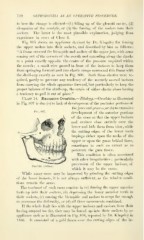Page 792 - My FlipBook
P. 792
—
•00 ORTHODONTIA AS AN OPERATIVE PROCEDURE.
to how the change is effected — (1) filling up of the glenoid cavity, (2)
elongation of the condyle, or (3) the forcing of the molars into their
sockets. The latter is the most plausible explanation, judging from
experience in cases of Class 4.
Fig. 805 shows an appliance devised by Dr. Kingsley for forcing
the upper molars into their sockets, and described by him as follows :
'' A frame covered the bicuspids and molars of the upper jaw, with arras
coming out of the corners of the mouth and extending along the cheeks
to a point exactly opposite the centre of the pressure required within
a small wire passed in front of the incisors to keep them
the mouth ;
from springing forward and two elastic straps connected this frame with
the skull-cap exactly as seen in Fig. 806. Both these elastics were re-
quired, partly to prevent any tendency of the recently moved incisors
from carrying the whole apparatus forward, but particularly to keep the
proper balance of the skull-cap, the strain of either elastic alone having
a tendency to pull it out of place."
Class 14. Excessive Overbite. Etiology.—Overbite as illustrated
in Fig. 807 is due (^?)to hick of development of the posterior portions of
the jaws and process, or (6) to excessive
Fig. 807.
development of the anterior portions
of the same so that the upper incisors
and canines close entirely over the
lower and hide them from view, while
the cutting edges of the lower teeth
impinge either upon the necks of the
upper or upon the gums behind them,
sometimes to such an extent as to
penetrate the gum tissue.
This condition is often associated
with other irregularities particularly
;
protrusion of the upper incisors, of
Overbite (Talbot).
which it may be the cause.
While many cases may be improved by grinding the cutting edges
of the lower incisors, it is not always sufficient, as the relative condi-
tions remain the same.
The treatment of such cases consists in («) forcing the upper anterior
teeth up into their sockets, (6) depressing the lower anterior teeth in
their sockets, (c) causing the bicuspids and molars to erupt far enough
to overcome the deformity, or ((/) all three movements combined.
If the whole fault lies with the upper incisors and canines from their
having erupted too far, they may be forced up into their sockets by an
appliance such as is illustrated in Fig. 808, reported by Dr. Kingsley in
1866. It consisted of a gold frame over the cutting edges of the in-
•00 ORTHODONTIA AS AN OPERATIVE PROCEDURE.
to how the change is effected — (1) filling up of the glenoid cavity, (2)
elongation of the condyle, or (3) the forcing of the molars into their
sockets. The latter is the most plausible explanation, judging from
experience in cases of Class 4.
Fig. 805 shows an appliance devised by Dr. Kingsley for forcing
the upper molars into their sockets, and described by him as follows :
'' A frame covered the bicuspids and molars of the upper jaw, with arras
coming out of the corners of the mouth and extending along the cheeks
to a point exactly opposite the centre of the pressure required within
a small wire passed in front of the incisors to keep them
the mouth ;
from springing forward and two elastic straps connected this frame with
the skull-cap exactly as seen in Fig. 806. Both these elastics were re-
quired, partly to prevent any tendency of the recently moved incisors
from carrying the whole apparatus forward, but particularly to keep the
proper balance of the skull-cap, the strain of either elastic alone having
a tendency to pull it out of place."
Class 14. Excessive Overbite. Etiology.—Overbite as illustrated
in Fig. 807 is due (^?)to hick of development of the posterior portions of
the jaws and process, or (6) to excessive
Fig. 807.
development of the anterior portions
of the same so that the upper incisors
and canines close entirely over the
lower and hide them from view, while
the cutting edges of the lower teeth
impinge either upon the necks of the
upper or upon the gums behind them,
sometimes to such an extent as to
penetrate the gum tissue.
This condition is often associated
with other irregularities particularly
;
protrusion of the upper incisors, of
Overbite (Talbot).
which it may be the cause.
While many cases may be improved by grinding the cutting edges
of the lower incisors, it is not always sufficient, as the relative condi-
tions remain the same.
The treatment of such cases consists in («) forcing the upper anterior
teeth up into their sockets, (6) depressing the lower anterior teeth in
their sockets, (c) causing the bicuspids and molars to erupt far enough
to overcome the deformity, or ((/) all three movements combined.
If the whole fault lies with the upper incisors and canines from their
having erupted too far, they may be forced up into their sockets by an
appliance such as is illustrated in Fig. 808, reported by Dr. Kingsley in
1866. It consisted of a gold frame over the cutting edges of the in-


